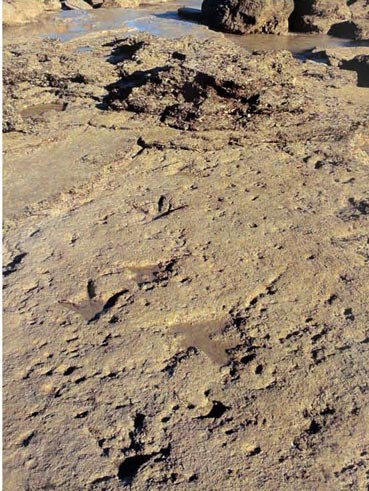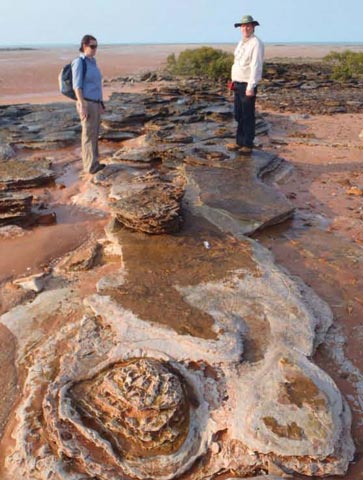Research being Carried out on the Dampier Peninsula Dinosaur Tracks
Usually when team members at Everything Dinosaur are asked to write about Australian dinosaur research, the focus is on sites in Queensland or indeed Victoria, however, a series of extensive dinosaur tracks located in Western Australia, along the Dampier peninsula north of the small town of Broome, are rapidly coming to prominence. In the Early Cretaceous, around 130 million years ago (Barremian faunal stage), Australia was much further south than it is today, it was not a separate continent but attached to the landmass that would become Antarctica.
Coal deposits and plant fossils indicate that the climate at this southerly latitude was much warmer than it is today, there was probably no permanent ice at the poles and the land that was to become Western Australia was a huge flood plain, crossed by large, slow moving rivers. Dinosaurs flourished in this environment and evidence of the diversity of the dinosaurs has been preserved in a multitude of dinosaur tracks. The trackways can be found all along the coast north of Broome, where the Lower Cretaceous Broome sandstone is exposed.
Dampier Peninsula Dinosaur Tracks
The lengths of the tracks are very significant, some of the trackways can be correlated over a tens of metres, they are regarded as “mega track sites”, otherwise known colloquially as “dinosaur freeways”.
Tridactyl Theropod Tracks from the Broome Area
Picture credit: Government of Western Australia (Dept. of State Development)
2011 Geological Survey
In a survey undertaken in 2011 a number of dinosaur trackways were classified and assessed, something in the region of fifteen different types of dinosaur have been identified including sauropods, ornithopods, theropods and armoured dinosaurs (Thyreophora).
Dr Steve Salisbury (University of Queensland), one of the researchers who carried out the study in 2011 is keen to see further research work undertaken and is enthusiastic about making the dinosaur tracks and trails better known to the public. However, it is important that any studies are undertaken with the utmost respect for the feelings of the local indigenous people as the tracks and footprints play an important role in local aboriginal art and culture. Dr Salisbury commented on the importance of these Cretaceous dinosaur footprints:
“There are some really important ones, scientifically and culturally, that we don’t really want to let everyone know where they are. But there are plenty of tracks that it would be fantastic to share them with people… Broome should embrace what it’s got on its doorsteps because it’s really special.”
Trying to Avoid Fossil Thefts
In addition, care should be taken when it comes to publicising the location of some of the tracks, thefts of dinosaur footprints have occurred and in 1996 prints made by an armoured dinosaur were stolen from the Crab Creek area on the north coast of Roebuck Bay. The theft of dinosaur fossils, even trace fossils such as footprints is an all too often occurrence, to read an article about the theft of a dinosaur footprint from Jurassic aged strata near to the town of Moab in Utah: Dinosaur Footprint Stolen in Utah.
Some of the sauropod prints (long-necked dinosaurs) are huge. Individual prints have been measured at over 1.7 metres long. Although ichnologists (the term used to describe a person who studies trace fossils), are not able to assign a genus to the footprints, it has been estimated that some of the sauropod dinosaurs that made the tracks were in excess of thirty metres in length.
Giant Sauropod Trackways from Western Australia
Picture credit: Government of Western Australia (Dept. of State Development)
The enormous, rounded prints of a sauropod dinosaur can be clearly seen in this picture taken in the Red Cliffs area.
Shedding More Light on the Ecology of the Early Cretaceous
The scientists hope that their studies will help shed more light on the ecology of this part of the world in the Early Cretaceous. The large number of different dinosaur species that the tracks potentially represent gives the palaeontologists the opportunity to learn a little more about the behaviour and interactions of the Dinosauria. The team intend to digitally map the locations using technology similar to that used recently to recreate the famous sauropod/theropod tracks preserved in the Paluxy River of Texas.
To read more about the Paluxy River trace fossils: Digitally Mapping a Famous Set of Dinosaur Tracks.
Dr Salisbury explained what the dinosaur footprints and tracks showed:
“Some of them look like they’re on a mission; they’re definitely heading somewhere. Other ones look like they’re lost, and they’re wandering around in circles… We’ve got a record of what they were doing and it’s a hundred and thirty million years old, so it’s pretty special. If you could go back in time and look at the Broome area, you would have seen all these different types of dinosaurs wandering around; it would have been really special. It’s your own Cretaceous Park, on your doorstep.”
Sacred to the Indigenous People
The tracks are sacred to the local indigenous people. The Aborigine tribes in the area believe that the tracks help explain their creation story and the scientists are keen to record the fossils, take latex rubber copies of the prints but to leave all the tracks in situ. The first recorded description of a print made by non-indigenous people dates back to the 1930’s but the entire region has not been fully studied to date. The survey undertaken in 2011 highlighted the importance and the significance of the location, now scientists are hoping to learn more by walking in the footsteps of dinosaurs.
Visit Everything Dinosaur: Everything Dinosaur.








Leave A Comment